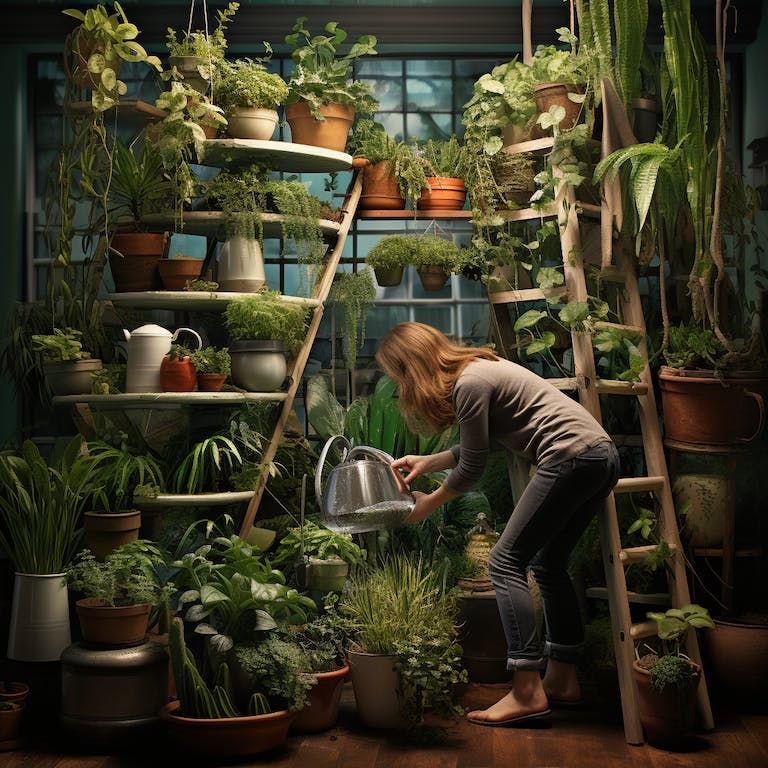Whether you’re a seasoned green thumb or just starting your indoor jungle, one thing is certain – happy plants make for happy homes. But, did you know that the key to a thriving indoor garden lies beneath the surface?
That’s right – proper drainage for your indoor plant pots is the unsung hero in the quest for flourishing foliage. In this blog post, we’re diving deep into the world of drainage, demystifying the why’s and how’s, and equipping you with simple yet effective tips to ensure your leafy companions get the care they deserve.
Say goodbye to soggy soil, root rot, and wilting wonders, and get ready to create an environment where your indoor plants can truly thrive. Let’s embark on this journey together – because a little TLC for your pots can go a long way in keeping your green companions happy and healthy!
Contents
- 1 Benefits of Proper Drainage for Indoor Houseplants
- 2 Make Use of Rocks and Pebbles for Indoor Plant Pot Drainage
- 3 What are Hydro Clay Pebbles and How to Use Them forPlant Pot Drainage
- 4 What Other Materials Can I Use to Make Indoor Plant Pot Drainage?
- 5 Tips for Watering Your Indoor Plants with Proper Drainage
- 6 Conclusion:
- 7 FAQs
- 7.1 Why is proper drainage important for indoor plants?
- 7.2 How can I tell if my indoor plant needs better drainage?
- 7.3 What materials can I use to improve drainage in my indoor plant pots?
- 7.4 Can I reuse the potting soil, or should I start fresh when improving drainage?
- 7.5 How often should I water indoor plants with proper drainage?
- 7.6 Do all indoor plants require the same type of drainage setup?
Benefits of Proper Drainage for Indoor Houseplants
There are a number of benefits to properly draining your indoor houseplants. For one, it helps to keep the plant healthy by preventing root rot. Additionally, it can help extend the life of your plant by preventing waterlogged soil, which can lead to nutrient deficiencies.
Finally, good drainage can help improve the overall appearance of your plant by allowing excess water to drain away from the leaves and stem.
One of the best ways to ensure proper drainage for your indoor houseplants is to use a pot with a drainage hole in the bottom. If your pot does not have a drainage hole, you can drill one yourself or add a layer of gravel to the bottom of the pot before adding the soil.
In addition to using a pot with a drainage hole, you should also make sure to water your plants evenly and not over-water them. Allowing the soil to become too wet can clog the drainage hole and prevent proper drainage.
If you notice that your plant is starting to wilt or its leaves are turning yellow, it is likely due to improper drainage. If you see any signs of root rot, such as mushy or blackened roots, it is important to act quickly and repot your plant in fresh, well-draining soil.
By taking proper care of your indoor plants and providing them with adequate drainage, you can keep them healthy and looking their best.

Make Use of Rocks and Pebbles for Indoor Plant Pot Drainage
Adding rocks or pebbles to the bottom of your indoor plant pots is a great way to improve drainage. By creating a layer of rocks, you can help to prevent water from sitting at the bottom of the pot and encourage it to drain more quickly.
This is especially important if you are using a pot with no drainage holes, as it will help to keep the roots from getting waterlogged.
There are a few things to keep in mind when using rocks for drainage. First, make sure that the rocks you use are clean and free of any chemicals or pesticides. Second, avoid using rocks that are too large, as they can block the drainage holes in the pot. Third, use a layer of rocks that is at least an inch thick to ensure good drainage.
If you are looking for a way to add some visual interest to your indoor plant pots, consider using decorative rocks or pebbles. You can find these at most garden centers or home improvement stores. Just be sure to rinse them off before using them in your pots to remove any dirt or debris.
So, next time you are planting an indoor plant, consider using rocks or pebbles to improve drainage. Your plants will thank you for it!
What are Hydro Clay Pebbles and How to Use Them forPlant Pot Drainage
Hydro clay pebbles are a type of clay that is often used in hydroponic gardening. They are a popular choice for plant pot drainage because they are very effective at absorbing water and keeping the roots of plants moist. Hydro clay pebbles are also very lightweight, so they are easy to add to your indoor plant pots.
To use hydro clay pebbles for drainage, simply add them to the bottom of your plant pot before adding soil. You can also add them to the top of the soil to help keep the roots of your plants moist. Make sure to water your plants regularly to keep the hydro clay pebbles moist.

What Other Materials Can I Use to Make Indoor Plant Pot Drainage?
If you’re anything like me, you’re always looking for new and creative ways to spruce up your home décor. And what better way to do that than by adding some plants? But if you’re not careful, indoor plants can be a disaster waiting to happen. That’s why it’s important to make sure your plants have proper drainage. Otherwise, you could end up with root rot, mold, and a big mess on your hands.
So what can you use for indoor plant pot drainage? Well, there are a few different options. First, you could use rocks or gravel. Simply place a layer of rocks or gravel at the bottom of your pot before adding your plant. This will help ensure that water drains properly and doesn’t pool at the bottom of the pot.
Another option is to use plastic mesh or screen. This is a great option if you’re worried about rocks or gravel getting caught in the drainage holes of your pot. Simply cut a piece of mesh or screen to fit the bottom of your pot, and place it over the drainage holes. This will allow water to drain through, but will keep rocks and gravel out.
Finally, you could use coffee filters. This is a great option if you’re looking for something that’s cheap and easy to find. Simply place a coffee filter over the drainage holes of your pot. This will allow water to drain through, but will keep soil from getting clogged in the drainage holes.

Tips for Watering Your Indoor Plants with Proper Drainage
It is important to water your indoor plants with proper drainage to avoid overwatering and root rot. By following a few simple tips, you can ensure that your plants stay healthy and thrive.
One of the most important tips for watering your indoor plants is to make sure that the pot has proper drainage. There are a few things you can do to ensure this.
First, you can make sure that there are drainage holes in the bottom of the pot. If there are no drainage holes, the water will just sit in the bottom of the pot and the roots of your plant will start to rot.
Second, you can add rocks or gravel to the bottom of the pot. This will help to keep the water from sitting in the bottom of the pot and will also help to aerate the roots of your plant.
Another important tip for watering your indoor plants is to water them in the morning. This will give the plant time to absorb the water before the hot sun dries it out. Watering in the evening can also work, but be sure to not water too late so that the water doesn’t have a chance to evaporate before morning.
When watering your indoor plants, be sure to water the soil, not the leaves. Watering the leaves can cause leaf spot and other diseases. Water the soil until it is moist, but not soggy.
Finally, fertilize your indoor plants every two weeks with a water-soluble fertilizer. This will help them to grow strong and healthy.

Conclusion:
In conclusion, proper drainage for indoor plant pots is essential to the health of your plants. There are a few things you can do to create proper drainage for your plants, including using a pot with a drainage hole in the bottom, mixing gravel or sand into the soil, or making slits in the soil with a sharp knife.
Whatever method you choose, make sure that the drainage holes in the bottom of your pot are not blocked. I hope this article was helpful in answering the question, “what can I put in my indoor plant pot for drainage?”
As always, feel free to leave any questions or comments below.
FAQs
Why is proper drainage important for indoor plants?
Proper drainage is crucial because it prevents water from pooling at the bottom of the pot, which can lead to root rot and other water-related issues. It ensures that your plant’s roots receive the right balance of moisture and oxygen, promoting overall plant health.
How can I tell if my indoor plant needs better drainage?
Watch out for signs like yellowing leaves, a musty smell, or soil that remains consistently damp. These can indicate poor drainage, causing stress to your plant. Adjusting the drainage system can help alleviate these symptoms.
What materials can I use to improve drainage in my indoor plant pots?
Consider adding materials like perlite, coarse sand, or pumice to your potting mix. These additives enhance aeration and drainage, preventing waterlogged soil.
Can I reuse the potting soil, or should I start fresh when improving drainage?
You can reuse potting soil but ensure it’s properly amended for better drainage. Remove any compacted or waterlogged soil, add fresh potting mix, and incorporate materials like perlite or sand to enhance drainage.
How often should I water indoor plants with proper drainage?
The frequency of watering depends on the specific needs of your plants and environmental conditions. With proper drainage, you’ll likely water less frequently, allowing the soil to dry out between waterings.
Do all indoor plants require the same type of drainage setup?
Different plants have varying moisture requirements. While many benefit from well-draining soil, some plants, like succulents, prefer a more arid environment. Research the specific needs of your plants to tailor the drainage accordingly.







